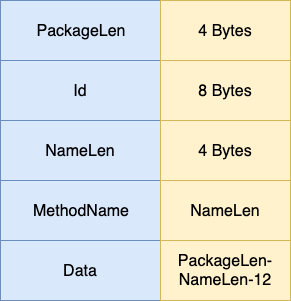实现了网络库之后,实现RPC就很简单了,重点是如何识别RPC函数和序列化消息,protobuf为我们提供了抽象,在proto文件中定义service字段它就会为我们生成RPC调用函数。
主要参考了muduo的RPC实现,纯异步。
pb生成代码分析
在proto文件中定义service
1 | service Logic { |
主要关注生成的pb.h中的这两个类,Logic是server端使用的,Stub是client用的,我们要做的就是实现Logic类中的虚方法和Stub中用到的RpcChannel。
1 | class Logic : public ::google::protobuf::Service { |
服务端的使用方法一般为1
2
3LogicServiceImpl logicservice_;
rpcserver.registerService(&logicservice_);
rpcserver.start();
客户端直接1
2Logic_Stub stub;
stub.Ping(NULL, request, response, done);
RpcChannel实现
RpcChannel代码中的注释写的很清楚:1
2
3// Abstract interface for an RPC channel. An RpcChannel represents a
// communication line to a Service which can be used to call that Service's
// methods.
代码注释中看到了protobuf的作者也有Jeff Dean…
我们继承protobuf的RpcChannel,持有网络库中的Session类,并实现Session中的回调函数,将Session中的onMessage回调设置为RpcChannel的onMessage函数,实现消息的收发,所以首先需要设计一下RPC协议,我设计了一个简单的二进制协议:

PackageLen表示包体长度,Id标识每条RPC消息,为什么需要Id?因为客户端请求时会设置收到消息后的回调,所以在收到消息时需要根据消息id执行相应的回调,因为客户端和服务端共用RpcChannel类,所以需要标识消息类型,这里简单把Id最高位为设为RPC标志位,0表示request,1表示response。为了唯一标识调用的RPC函数,使用servicename:methodname拼起来作为消息名存在MethodName,最后是数据,放在Data。
Client接收回复
我的实现方法是定义了一个RpcCodec作协议编解码,在RpcChanel的onMessage中调用codec的协议解析函数将协议的各个字段解析出来,之后调用onRpcMessage处理一个完整的消息。在onRpcChannel中根据消息是请求还是回复作不同的处理,如果是回复,就根据id调用设置的回调,这里还有一个问题?怎么把data反序列化成回调需要的参数类型呢?1
2
3
4
5struct OutstandingCall
{
::google::protobuf::Message* response;
::google::protobuf::Closure* done;
};
其实这里不只保存回调函数,还把请求时的response保存了,所以可以直接反序列化。
Server端接收请求
如果是请求,那么我们需要调用相应的serviceimpl的实现,那怎么拿到对应的service呢?如何生成对应方法的参数呢?这就需要服务端维护一个servicename对应的servicemap,就可以根据name查找service,利用protobuf提供的反射功能,有了service和method的name,我们也可以生成对应的参数。
1 | const google::protobuf::ServiceDescriptor* desc = service->GetDescriptor(); |
首先根据servicename拿到我们自己保存的对应的service,然后用ServiceDescriptor根据methodname拿到MethodDescriptor,然后就可以生成req和resp消息了,有了MethodDescriptor,service的CallMethod
就可以分发到对应的函数了。
Client发送请求
最后分析一下客户端发消息的流程,Stub调用的是RpcChannel的CallMethod函数,只要在函数中保存回调,调用codec的send函数按协议组装发送就好了。
关于回调,protobuf生成的代码中类型是Closure,可以用NewCallback函数创建,但是有一个限制,回调函数的参数最多只能有两个,如果定制只能自己写代码生成或者改NewCallback的实现。
总结
框架只实现了基本的消息收发,RPC里能做的还有很多,服务发现,熔断,限流,链路追踪。这里只是实现一个demo了解一下RPC原理。
Client发请求:Stub.Ping()->RpcChannel.CallMethod()->RpcCodec.send()
Client收回复:RpcChannel.onRpcMessage()->根据servicename找到service,根据methodname生成Descriptor,生成函数参数->service.CallMethod()->调用对应RPC函数
Server收请求:RpcChannel.onRpcMessage()->根据id调用回调